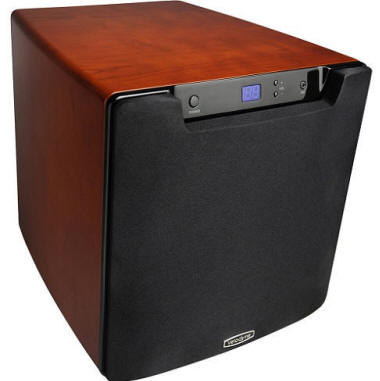|
You are reading the older HTML site Positive Feedback ISSUE 48march/april 2010
The Neoteric Listener...
and the Velodyne Optimum-10 subwoofer
When I first posited the notion of reviewing a Velodyne subwoofer to PFO editor Dave Clark, he politely suggested that the model being considered was probably too much for my shack. What he was really saying was, "Why in the world would anyone living in a such a broom closet want more bottom end than it has when you're sitting in it?" Which is all very sensible and correct. For my little room, my Tannoys are adequate, and the Nola Boxers currently in my system (review forthcoming) don't need any help in the bass department, so what's the point? After all, like canons and current, too much speaker sounds like a good idea until it all blows up in your face. But anybody who has standmounts (or modestly endowed floorstanders for that matter) knows the answer to this question. No matter how good the sound, there are those selections, those certain moments when you just want the presentation to be a little more... well, a little more. So when I asked Ann Gargiulo of Veleodyne which model would be the best, she replied, "Well... in our humble opinion, you can never have too big of a sub, so we think an Optimum-10 is just fine for your room." As if I needed convincing! She graciously offered me the option of receiving both the Optimum-10 and its smaller sibling, the Optimum-8. It barely needs mentioning that only asked for the 10. What if I pushed the 8 to the edge of distraction and realized that I needed to go 2 better? I imagine that, once we've plunked down a good bit of cash for our new basso profund-o machine, most of us are going to make a beeline for all of our recordings "on the down low." That's certainly what I did, anyway, and so a big part of my listening featured plenty of large orchestras, synthesized bass, and Fender P's. First up was the RCA Victor Symphony Orchestra (Robert Russell Bennett conducting) playing "The Song of the High Seas" from Richard Rodgers' Victory at Sea. Right then and there, I realized my folly for not heeding my editor's caution. The clash of kettle drums, double basses, booming brass, and swirling string arrangements nearly Japanese-lanterned my rectangular listening room by pushing out the sidewalls. I guess I could've gotten by with the Optimum-8, at that. But, man, what a glorious rush of nautical noise! When I muted the Velodyne to measure the contrast, my seven seas went from swashbuckling to salad dressing. Even though the Optimum-10 is not as large as the some subwoofer tanks, it has plenty of power for any small to medium sized room, no matter how club-like your atmosphere, and I'd bet that it would be perfectly adequate for a larger room at sane levels.
Unlike some subwoofers I've auditioned, the Optimum-10 enables me to hear the texture of instruments typically too low in frequency to be adequately detected, much less enjoyed. Unless you're a large sea animal, all recordings are something of a subsonic guessing game, because our ears just aren't tuned to easily retrieve that information. Biology favors voice recognition, I guess, and while some people may miss the bassoon, nobody has trouble hearing the banjo. Moreover, all subwoofers, even poor ones, push out that familiar low-frequency physical sensation of "feeling" the sound. It's a fun effect for a little while, but soon you want off the carnival ride. What's nice about the Optimum-10, however, is that it can give up tremendous low-frequency information even at the low subwoofer settings that I feel comfortable with for everyday listening. But just in case you're wondering, this sub can still wallop the bejeezus out of your best techno and electronica and still have plenty left for your Wagner Ring and German speed metal collection. To illustrate, Yello's "Call it Love" is more than the usual staple of "boom, boom, boom." This song is a wonderful mixture of softly intoned voices, overdriven guitar fills, and theatrical effects panning that rewards a setup rich on soundstaging and dynamic attack. The Velodyne Optimum-10 has the fluidity to fill the spaces of the room with mammoth bass runs without obscuring the lighting quick appearances and disappearances of the guitars, vocal intonations, and secondary instruments. As with most Yello tunes, electronic bass is front and center (and sideways and ceilingways and definitely floorways) but in this instance, it's the syncopation between the the bass and the rhythm guitar that holds the song together. The first thing that I noticed when playing this selection is how well the Velodyne's auto-EQ works. Plug in the microphone, sit in the desired listening spot, press the EQ button on the sub's remote, and wait for it to send out 12 test tones designed to shape the EQ for best effect. Personally, I'm not the sort who's going to walk around the room with an SPL meter and a t-square to find the prime subwoofer placement. In my shack, the calculus for perfect sound involves a jack hammer and an eviction notice, so I let the Optimum-10 do all the math, and I was very pleased by the results. The most dramatic difference that I noticed was in the improvement in the overall coherence of the sound. While it may have been true in days past that subwoofers were mainly designed to mimic the rat-ta-tats and kablams heard in a movie theatre, today's subwoofers can do more than ripple the surface of your soda pop. Yes, the Optimum-10 worked superbly in adjunct with my blue ray player, and in home theater applications I can't see how anyone could want more, but its primary virtue is its talent for making music playback richer and more fulfilling. If you're old enough, you know that learning how to play bass guitar once involved a lot of time picking up the tone arm and replaying passages so that you could figure out what the hell was going on buried way, way, down in the mix. I spent plenty of afternoons with borrowed basses trying to unearth enough notes to bluff my way through ragged evening rehearsals, and it gave me a certain love-hate relationship with the rock n' rotosound of most pop/rock recordings. Today, while not everyone appreciates modern remixes of past masters, there's no doubt that one of the prime directives for engineers is to be able to discern every track from one to sixteen. It may not always be music, but it sure is separate. Anyway, playing the recent Rolling Stones Beggar's Banquet SACD, it was definitely a treat to be able to appreciate Bill Wyman's bass lines on "No Expectations." One of the premier examples of Englishman's blues, the bass work on this song ties together the simple arrangement rhythm, slide guitar, bass guitar and vocals (other than wood blocks, Charlie spends most of his time sipping Watney's Red Barrel on this cut). This song is no Yello slam fest, no orchestral epic, why would anyone need or want a subwoofer? All you need to do is listen to how much a good subwoofer adds to the sonic presentation of this song to see how essential a subwoofer is in conveying a more satisfying auditory experience. Besides the speed of the Velodyne-10, what I really find of value is it's talent for rendering even the lowest frequencies as musical tones, and not just as loud caricatures of the notes being played. On Bhatt, Douglass and Meyer's album Bourbon and Rosewater, the title track is a Delta-meets-the Dehli corn stew featuring plenty of fast picking and swamp blues done North Indian style. With the Optimum-10, the rich, pulsating drone of the bass enables the dobro and the mohan vina to engage in a free play of virtuoso runs and harmonized melodies. With the subwoofer muted, the third side of the triangle is removed and the trance is diminished. The Optimum enables the lower frequency to be heard and enjoyed, while still keeping pace with all of the commotion going on at ear level, which is exactly what you'd like in a good subwoofer. Finally, if nothing else convinces you that this is a subwoofer that deserves your consideration, then audition it just to experience the marvelous remote that sets the volume, offers up to four phase options and four EQ presets, turns on and off the display light, and even enables you to select a night setting for listening to music in the deep a.m. without disturbing granddad in repose. As someone who loves to tinker with the volume and settings of subwoofers, this remote is worth the $1699 MSRP (although the street price is about $400 lower) price of admission alone. Ok, maybe I could've gotten by with the Optimum-8, but the Optimum-10 has been such a larger than life houseguest, it just won't be nearly as much fun without the Velodyne to show the picture below the bottom of the frame. I found this subwoofer to be not only powerful, which is easy, but also extremely musical, which is a tougher challenge. Plenty of handy features, too! Available in hand-rubbed black gloss (I was shipped a stunning example of this finish) or cherry veneer, the Optimum-10 is relatively compact, as subwoofers go.
Optimum-10 Subwoofer
Velodyne
|


